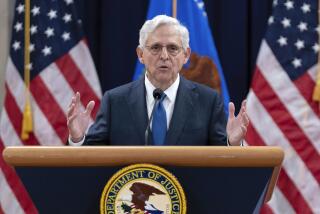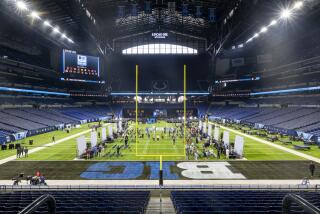FDIC begins to reveal settlements related to financial crisis
- Share via
The Federal Deposit Insurance Corp. has begun posting online more than 200 previously undisclosed settlements related to bank failures that accompanied the financial crisis.
The revelations come in response to a Los Angeles Times story last week that examined the FDIC’s policy of quietly settling civil claims involving failed banks, sometimes with “no press release” clauses to help bankers avoid embarrassment.
The first three settlements, involving Florida banks that failed in 2008 and 2009, were put online Friday at FDIC.gov. The agency said all such agreements reached from 2007 through 2012 would be posted by the end of the day Monday. Settlements from 2013 were to follow “shortly,” with regular updates made thereafter.
Under the Federal Deposit Insurance Corp. Improvement Act of 1991, passed in the aftermath of the savings and loan crisis of the 1980s, the settlements can’t be kept secret. But a Times review of the agreements, obtained through a Freedom of Information Act request, revealed that some agreements included deals binding the FDIC not to release the information except in response to a specific inquiry.
In other cases, the agreements didn’t include written promises to conceal the settlements, but lawyers for the FDIC made oral promises of confidentiality or announced only a portion of settlement agreements with former bank officers and directors.
In a statement released Monday by FDIC spokesman Andrew Gray, the agency said: “The FDIC agrees that there should be no constraint on the release of public information and as a matter of policy will no longer agree to such clauses in future settlements.”
In an interview, Gray said the FDIC takes its burden of accountability to the public seriously. As for the practice of secrecy clauses, he said: “I’m not going to try to defend it.”
Gray did offer a rationale, which he attributed to FDIC attorneys: “If this got them to close the deal, they didn’t view it as a giveaway, because it wouldn’t preclude us from making the settlement public” upon request, he said.
FDIC Chairman Martin J. Gruenberg and Richard J. Osterman, its acting general counsel, weren’t available for comment Monday. Former Chairwoman Sheila Bair — who led the agency when most of the settlements were completed — declined to comment.
The Times report prompted widespread criticism of the agency. William K. Black, a law professor at the University of Missouri in Kansas City and former senior bank regulator, chastised the FDIC in an opinion piece for the Huffington Post. The agency, Black wrote, was “unwilling or incapable of summoning the moral courage to litigate” against Michael Perry, the former chief executive of Pasadena’s IndyMac Bank, whose failure cost the agency $13 billion — the biggest loss in its 80-year history.
Perry settled an FDIC claim for $1 million of his own money. He agreed to be banned from the banking industry and allowed the agency to pursue additional damages from IndyMac’s liability insurers.
“Is there no one who has had enough and will insist that the fraudulent controlling officers limp away bankrupt rather than strut away wealthy?” Black wrote.
In an email to The Times, Black also lashed out at the FDIC’s explanation that the documents were available to anyone who asked.
“There are few things worse than those who plot to lie artfully,” he said.
The FDIC clearly intended to circumvent the non-secrecy rule, said Bart Dzivi, a former U.S. Senate Banking Committee attorney who wrote the provision and recently served as special counsel to the Financial Crisis Inquiry Commission.
“It is abundantly clear this [no press release] clause was expressly designed to hide those public materials from public view,” said Dzivi of Sausalito, Calif. “They went as far as they could in keeping it secret without breaking the law.”
Richard Newsom, a former bank examiner who specialized in insider-abuse cases for the FDIC in the aftermath of the savings and loan debacle, called the FDIC practice “one more piece of evidence demonstrating the unholy collusion between timid and occasionally rogue government officials and rogue banks” to conceal wrongdoing by banks and lax oversight by regulators.
Gray, the agency spokesman, tried to turn the discussion toward the future. “We’re going to be more transparent,” he said.
More to Read
Inside the business of entertainment
The Wide Shot brings you news, analysis and insights on everything from streaming wars to production — and what it all means for the future.
You may occasionally receive promotional content from the Los Angeles Times.











